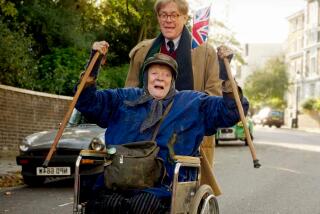Review: Martha Graham at VPAC: Dance as bridge from past to future
The importance of Martha Graham in modern dance can’t be overstated: Like Picasso and Stravinsky, she is credited with bringing a classical art form forcibly into the 20th century through radical, and shocking, innovation. The earthy, jangly, often purposely unlovely style she pioneered so permeates our cultural landscape that we tend to take it for granted.
The Martha Graham Dance Company, which Graham founded in April 1926 and which has continued to perform since her death in 1991, has set itself the task of honoring her legacy without preserving her in amber -- often a doomed enterprise. But on its 89th birthday, the company performed a program at the Valley Performing Arts Center in Northridge that joyously balanced the past with the future.
Of the four dances, two were choreographed by Graham in the 1940s and two were by contemporary choreographers responding to her work. The impression was of artists engaged in a mutually respectful, affectionate and inspirational conversation across time.
The first, “Appalachian Spring,” faithfully and tenderly revived Graham’s most famous ballet, with its stirring score by Aaron Copland and its stark, abstract set by Isamu Noguchi. This influential work was first presented at the Library of Congress in 1944, starring Graham and her fellow company member Merce Cunningham as a newly married pioneer couple, the Bride and the Husbandman (here danced by Blakeley White-McGuire and Abdiel Jacobsen), who anticipate together a life of simple gifts, while a preacher (Lloyd Knight) and his four female followers prance ecstatically around them.
The choreography is arresting, sometimes startling. The dancers slap their own bodies, hop and spring and scuttle along on their knees. At times they seem barely tethered to the stage. Their unexpected gestures convey a touching innocence and freshness. According to the company’s artistic director, Janet Eilber, who introduced the evening, Graham and her collaborators intended “Appalachian Spring” as a testimony to the spirit of America. “It was their contribution to the war effort,” she said.
Although “Appalachian Spring” is charming to its core, it was in the second piece, “Lamentation Variations,” that the intergenerational dialogue began to catch fire. In 2007, Eilber asked contemporary choreographers to create responses to Graham’s 1930 solo piece, “Lamentation,” for a commemoration of 9/11. The choreographers were invited to create original four-minute dances (about the length of the original) in no more than 10 hours of rehearsal. The initial “Variations” were intended to be performed only once, but they proved so fruitful that the company continued the project. They have collected 12 variations since, Eilber said, and had prepared three for this performance.
But first, on a giant screen, the audience got to see what the choreographers were responding to: Film clips of Graham in “Lamentation.” The crackly footage, played without any sound, still has a revolutionary power; projected at such a scale, it seemed like an allegory for the anxiety of influence. How could anyone dare to dance in the wake of this colossal performance?
In the clips from “Lamentation,” Graham wears a shroud-like tube of fabric in which she writhes in apparent agony. Her face is harshly powdered in white, and her black eye makeup looks smudged. Her movements are strange and unnatural; at moments she swings her arms repetitively from side to side like a malfunctioning clockwork figure. She depicts grief as inescapable imprisonment in one’s own skin, with no relief or comfort.
The three ensuing variations did not achieve the same effect; it was difficult, after the giant projected Graham, to adjust to the smaller scale of live dancers onstage. Also the variations were performed by groups, rather than in the stark isolation of the original. The first, by Larry Keigwin, featured the full company dancing together in a more gentle discordance to Chopin’s Nocturne in F Sharp, like people huddling together in an effort to find consolation in the wake of Graham’s hellish vision.
The second piece, by Kyle Abraham, was enchantingly smooth and lovely, lacking the agony of the original. The third response, by Sonya Tayeh of “So You Think You Can Dance” fame, was set to a frightening score by Meredith Monk, consisting of menacing whispers and gasps, and added a more explicit investigation of the sexual politics only suggested in the original.
The “Lamentation Variations” could conceivably continue forever, as choreographers study and respond to Graham’s work, educating themselves and their audience in the process.
After the intermission, sexual politics were explored further in two pieces inspired by Greek mythology. The first, “Errand Into the Maze,” was Graham’s version of the myth of the Minotaur. In her vision, it is not Theseus who ventures into the maze to confront the beast but Ariadne, here performed by the exquisite PeiJu Chien-Pott. Here the company dispenses with the original costumes and set. Chien-Pott dances in a simple white dress; Ben Schultz has a thrilling physicality as the yoked, muscular Minotaur.
Finally came “Echo,” a dance choreographed in 2014 by Andonis Foniadakis. Inspired by the myth of Echo and Narcissus, it features two male dancers, Jacobsen and Lloyd Knight, drowning in their admiration for each other, while a woman, Ying Xin, attempts to distract them from mutual absorption. The performers’ grace and physicality is gorgeously exploited by the mesmerizing choreography. The costumes, by Anastasios Sofroniou, are particularly effective in their woodsy shades of ochers and browns and blacks. This performance ends the evening in a swirl of movement, thought and color.
More to Read
The biggest entertainment stories
Get our big stories about Hollywood, film, television, music, arts, culture and more right in your inbox as soon as they publish.
You may occasionally receive promotional content from the Los Angeles Times.










